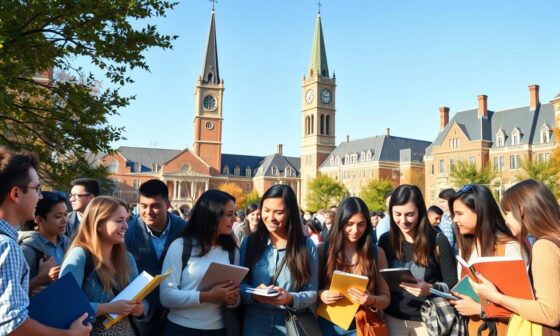Are you an aspiring international student wondering what it takes to secure a spot at a top US university? The journey to admissions success can be daunting, but with a well-planned strategy, you can increase your chances of achieving your dreams.
Applying to US universities as an international student comes with its unique set of challenges. From navigating complex application processes to meeting stringent admission requirements, the path to study abroad success requires careful planning and preparation.
By understanding the key factors that contribute to a successful application, you can take the first step towards making your study abroad aspirations a reality.
Key Takeaways
- Crafting a well-planned application strategy is crucial for admissions success.
- Understanding the unique challenges faced by international students is essential.
- Meeting admission requirements and navigating application processes are key.
- A successful application requires careful planning and preparation.
- Understanding the factors that contribute to a successful application is vital.
Understanding the US University Landscape
Navigating the US higher education system can be challenging, but understanding its structure is key to making informed decisions. The US is home to a diverse array of higher education institutions, each with its unique characteristics and strengths.
Types of US Higher Education Institutions
US higher education institutions can be broadly categorized into several types, including community colleges, liberal arts colleges, public universities, private universities, and specialized institutions. Community colleges offer two-year programs, while liberal arts colleges focus on undergraduate education. Public universities are funded by state governments, whereas private universities rely on tuition and private funding.
Differences Between Public and Private Universities
Public universities are generally larger and offer a wider range of programs, while private universities tend to be smaller and more selective. The funding models also differ, with public universities receiving state funding and private universities relying on tuition and endowments.
Understanding the US Academic Calendar
The US academic calendar varies across institutions, with some following a semester system and others a quarter system. Understanding these systems is crucial for planning.
Application Cycles and Admission Seasons
US universities have different application cycles, including Early Decision, Early Action, and Regular Decision. Understanding these cycles is vital for meeting deadlines.
| Institution Type | Funding Model | Typical Size |
|---|---|---|
| Public Universities | State-funded | Large |
| Private Universities | Tuition and endowments | Small to Medium |
| Community Colleges | Local funding | Varies |
Planning Your Application Timeline
A well-structured application timeline is the backbone of a successful college application process for international students. It helps in organizing tasks, meeting deadlines, and ensuring that all required materials are submitted on time.
When to Start the Application Process
It’s recommended that international students start the application process at least 12-18 months before the intended enrollment date. This allows ample time for standardized testing, gathering documents, and completing applications.
Key Application Deadlines
Understanding key application deadlines is crucial. These include deadlines for Early Decision, Regular Decision, and Rolling Admissions. Each has its own implications and benefits.
Creating a Month-by-Month Planning Calendar
To stay organized, create a month-by-month planning calendar. This should include tasks such as:
- Researching universities
- Preparing for and taking standardized tests
- Drafting and finalizing application essays
- Securing letters of recommendation
Early Decision vs. Regular Decision Considerations
When deciding between Early Decision and Regular Decision, consider your level of commitment to the university and the potential impact on financial aid. Early Decision demonstrates a strong commitment but can limit flexibility.
Researching and Selecting Target Universities
Selecting the right US university is a crucial step for international students aiming to study abroad. With thousands of institutions to choose from, the process can be daunting. However, by focusing on specific factors, students can narrow down their options and create a list of universities that best fit their academic goals and personal preferences.
Finding Universities That Match Your Academic Goals
The first step in researching US universities is to identify institutions that offer strong programs in your desired field of study. Look for universities that are known for their academic excellence in your area of interest. You can use online resources such as university rankings and academic databases to find this information.
Considering Location, Size, and Campus Culture
Beyond academics, factors such as location, university size, and campus culture play significant roles in your overall educational experience. Some students prefer the bustling environment of a large city, while others thrive in a smaller, more intimate setting. Consider what kind of environment you prefer and look for universities that match your preferences.
Creating a Balanced List of Reach, Match, and Safety Schools
When finalizing your list of target universities, it’s essential to create a balanced mix of “reach,” “match,” and “safety” schools. Reach schools are those that are highly competitive and may be a stretch, match schools are those where your credentials align with the average admitted student, and safety schools are those where you are likely to be accepted. This strategy helps ensure that you have viable options when applying.
Using Online Resources and Virtual Tours
Utilize online resources, including university websites and virtual tours, to get a feel for each campus. Many universities offer virtual tours that allow you to explore campus facilities, student life, and local surroundings from the comfort of your home. This can be particularly helpful for international students who cannot visit in person.
Meeting Standardized Testing Requirements
Understanding the various standardized tests required by US universities is essential for international students’ success. These tests are a crucial part of the admissions process, assessing a student’s readiness for higher education in the United States.
Understanding the TOEFL/IELTS Requirements
International students must demonstrate English proficiency, typically through the TOEFL or IELTS exams. TOEFL is widely accepted, with scores ranging from 0 to 120. IELTS scores range from 0 to 9. Most universities require a minimum TOEFL score of 80 or an IELTS score of 6.5.

| Test | Score Range | Minimum Score Required |
|---|---|---|
| TOEFL | 0-120 | 80 |
| IELTS | 0-9 | 6.5 |
Preparing for the SAT/ACT
For undergraduate admissions, many US universities require either the SAT or ACT. The SAT scores range from 400 to 1600, while the ACT composite score ranges from 1 to 36. Preparation is key, as these tests assess a student’s readiness for college-level work.
Subject-Specific Tests and When They’re Required
Some universities require subject-specific tests, particularly for certain majors or programs. These can include SAT Subject Tests or AP exams.
GRE and GMAT for Graduate Students
Graduate programs often require either the GRE (Graduate Record Examination) or GMAT (Graduate Management Admission Test). The GRE is more widely accepted, with scores ranging from 260 to 340. The GMAT scores range from 200 to 800.
| Test | Score Range |
|---|---|
| GRE | 260-340 |
| GMAT | 200-800 |
Meeting these standardized testing requirements is a critical step in the admissions process for international students. By understanding the tests required and preparing accordingly, students can enhance their chances of success.
Navigating Financial Considerations
The financial implications of studying in the US are multifaceted and require a comprehensive approach. International students must consider various factors, including tuition fees, living expenses, and other costs associated with higher education in the US.
Understanding the True Cost of US Education
The cost of studying in the US encompasses more than just tuition fees. It includes living expenses, health insurance, and other miscellaneous costs. On average, the annual cost of attending a US university can range from $20,000 to over $50,000, depending on the institution and location.
Scholarships and Financial Aid for International Students
Various scholarships and financial aid options are available to help international students fund their education. These include merit-based scholarships, need-based financial aid, and government-funded programs. It’s essential to research and apply for these opportunities early.
Demonstrating Financial Capability for Visa Purposes
To obtain a student visa, international students must demonstrate their financial capability to cover tuition fees and living expenses. This involves providing proof of funds, such as bank statements or scholarship awards.
Working Options and Restrictions for International Students
International students in the US can work part-time on campus, subject to certain restrictions. Understanding these regulations is crucial to maintaining visa status while studying. Students should familiarize themselves with the rules governing on-campus employment and optional practical training (OPT) programs.
Achieving Admissions Success: International Students’ Guide to US Universities
Securing a spot in a US university as an international student demands a comprehensive understanding of the application process. To stand out, it’s crucial to craft a compelling application that highlights your unique strengths and perspectives.
Writing a Standout Personal Statement
Your personal statement is a critical component of your application, offering a chance to tell your story and showcase your goals. To make it impactful, focus on your international perspective and how it enriches your profile. Highlight experiences that demonstrate your adaptability, resilience, and leadership skills.
For instance, if you’ve navigated different educational systems or overcome language barriers, these experiences can be powerful narratives. Use specific examples to illustrate your points, and ensure your statement is well-structured and free of errors.
Highlighting Your International Perspective as a Strength
As an international student, your diverse background is a significant asset. Emphasize how your international perspective can contribute to the university community. Discuss how your experiences and viewpoints can enhance classroom discussions and campus life.
Universities value diversity, so highlighting your unique cultural insights and experiences can make your application more compelling. Be sure to connect your international background to your academic and career goals, demonstrating how they align with the university’s mission.
Securing Strong Letters of Recommendation
Letters of recommendation provide insight into your abilities and potential from the perspective of those who know you well. Choose recommenders who can speak to your strengths and achievements. It’s essential to give them sufficient time to write a thoughtful letter.
Helping Your Recommenders Understand US Expectations
US universities look for letters that provide specific examples of a student’s skills and accomplishments. Guide your recommenders by sharing your resume, personal statement, and any relevant achievements. This will help them tailor their letters to highlight your strengths in a way that resonates with US admissions committees.
| Tips for Recommenders | Description |
|---|---|
| Provide Specific Examples | Encourage recommenders to use concrete examples to illustrate your skills and achievements. |
| Highlight Achievements | Recommenders should focus on your accomplishments and how they relate to your future goals. |
| Showcase Soft Skills | Emphasize qualities like leadership, teamwork, and problem-solving abilities. |
By following these guidelines and ensuring that all components of your application are strong, you can significantly enhance your chances of admissions success.
Preparing Academic Credentials for US Evaluation
International students seeking to study in the US must navigate the complex process of preparing their academic credentials for evaluation. This step is crucial in the admissions process, as US universities need to assess the academic qualifications of international applicants to determine their eligibility.
Transcript Translation and Evaluation Services
One of the key steps in preparing academic credentials is obtaining transcript translation and evaluation services. Many US universities require transcripts to be translated into English and evaluated by a recognized credential evaluation service. This process ensures that the transcripts are in a format that US institutions can understand and compare to their own academic standards.
Credential evaluation services assess the authenticity and academic equivalence of international transcripts. Some prominent services include the World Education Services (WES) and the Educational Credential Evaluators (ECE). These services provide a detailed report that compares the applicant’s academic credentials to US standards, facilitating the admissions decision.
Understanding GPA Conversion
GPA conversion is another critical aspect of preparing academic credentials. US universities often require international students to convert their GPA to a US equivalent. This process involves recalculating the student’s grades on a 4.0 scale, which is the standard GPA scale used in the US.
The GPA conversion process can be complex, as different countries have different grading systems. Some universities provide guidelines for GPA conversion, while others may rely on the credential evaluation services to perform this task.
Demonstrating Academic Equivalency
Demonstrating academic equivalency is essential for international students. This involves showing that their previous academic achievements are comparable to those of US high school graduates or previous university students, depending on the level of study they are applying for.
Handling Credential Verification Challenges
Credential verification can sometimes pose challenges, especially if the documents are in a language other than English or if there are discrepancies in the records. In such cases, it’s essential to work with reputable credential evaluation services that can verify the authenticity of the documents and provide a detailed evaluation report.
| Service | Description | Cost |
|---|---|---|
| WES | World Education Services – comprehensive credential evaluation | $100-$200 |
| ECE | Educational Credential Evaluators – detailed report on academic equivalency | $150-$300 |
| SpanTran | Specializes in transcript evaluation and verification | $120-$250 |
By understanding the requirements for transcript translation, GPA conversion, and demonstrating academic equivalency, international students can better prepare their academic credentials for US university evaluation, enhancing their chances of a successful application.
Mastering the Admissions Interview
As international students navigate the complex process of applying to US universities, mastering the admissions interview is key to success. This crucial step allows students to demonstrate their academic readiness, cultural adaptability, and personal qualities that make them a good fit for the institution.

Preparing for In-Person vs. Virtual Interviews
With the rise of digital communication, admissions interviews can be conducted either in-person or virtually. In-person interviews require students to be physically present, often on campus, and demand a different level of preparation, including travel arrangements and in-person etiquette. On the other hand, virtual interviews are conducted via video conferencing tools, requiring students to be technically prepared and to have a suitable, distraction-free environment.
- For in-person interviews, research the campus culture and be prepared to ask informed questions.
- For virtual interviews, ensure your technology is reliable, and practice using it to avoid any last-minute issues.
Common Questions for International Applicants
International applicants often face a set of questions that are designed to assess their language proficiency, academic background, and cultural adaptability. Some common questions include:
- Why do you want to study in the US?
- How do you plan to overcome language barriers?
- What are your academic and career goals?
Being prepared to answer these questions confidently and concisely is crucial.
Cultural Considerations During Interviews
Cultural differences can sometimes lead to misunderstandings during interviews. Being aware of these differences and adapting your responses accordingly can make a significant difference. For example, in some cultures, direct eye contact is seen as a sign of confidence, while in others it may be considered rude.
Following Up After Your Interview
After the interview, it’s essential to follow up with a thank-you note or email to express your gratitude for the opportunity and to reiterate your interest in the program. This not only shows good manners but also keeps you on the radar of the admissions committee.
“A well-crafted follow-up can leave a lasting positive impression.”
Navigating the Student Visa Process
International students must navigate the intricacies of the F-1 visa application process to study in the US. This process involves several critical steps, from understanding the requirements for an F-1 visa to maintaining visa status after acceptance.
Understanding F-1 Visa Requirements
The F-1 visa is a non-immigrant visa that allows international students to pursue education in the United States. To qualify, students must be accepted into a US institution, demonstrate sufficient financial resources, and intend to return to their home country after completing their studies. It’s crucial to understand that the F-1 visa is specifically for academic purposes.
Students should prepare the necessary documentation, including a valid passport, Form DS-160 confirmation, proof of financial capability, and the SEVIS fee payment receipt. Ensuring that all documents are in order is vital for a smooth application process.
Preparing for Your Visa Interview
The visa interview is a pivotal part of the application process. Students should be prepared to discuss their academic plans, financial situation, and ties to their home country. Practicing common interview questions can significantly boost confidence.
It’s also essential to be aware of the cultural nuances during the interview. Being respectful and clear in responses can make a positive impression. Students should dress appropriately and arrive early for their interview.
Maintaining Visa Status After Acceptance
Once a student visa is granted, maintaining the visa status is crucial. This involves making normal progress towards completing the course of study, not engaging in unauthorized employment, and reporting any changes in address or academic program to the relevant authorities.
Handling Visa Denials and Reapplications
In the event of a visa denial, understanding the reasons behind the denial is crucial. Common reasons include insufficient ties to the home country or inadequate financial proof. Students can reapply after addressing the issues that led to the denial.
It’s advisable to seek guidance from the educational institution’s international student office or an immigration attorney to navigate the reapplication process effectively.
Conclusion: Your Path to Success in US Higher Education
Achieving admissions success as an international student in US higher education requires careful planning, dedication, and a clear understanding of the application process. By following the essential tips outlined in this article, you can enhance your chances of securing a spot at a top US university.
From understanding the US university landscape to navigating the student visa process, each step plays a crucial role in your journey to study abroad. Stay focused on your goals, and remember that US higher education offers a wealth of opportunities for academic and personal growth.
As you move forward, keep in mind that admissions success is not just about gaining acceptance; it’s about finding the right fit for your academic aspirations. With persistence and the right guidance, you can unlock the doors to a world-class education and a brighter future.




